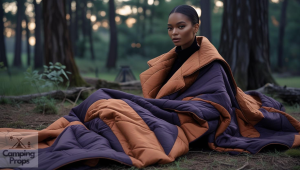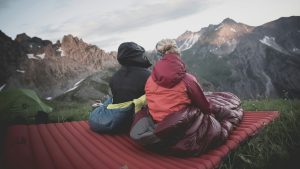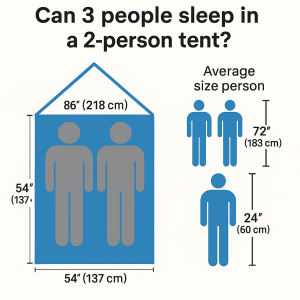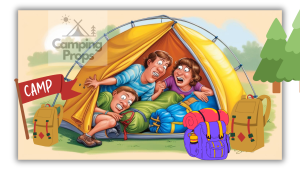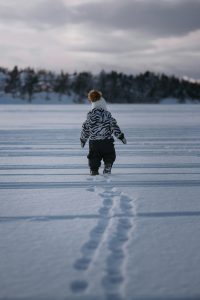Camping is one of the best ways to reconnect with nature, relax, and have some fun away from the hustle and bustle of everyday life. But to make the most of your outdoor experience, camping safety should always be your top priority. Whether you’re heading out on a solo trip, camping with family, or organizing a group adventure, being well-prepared can help prevent accidents and ensure a safe, enjoyable time in the wild.
In this guide, we’ll cover essential camping safety tips to help you stay safe, from fire safety and food storage to dealing with weather and wildlife. Let’s dive in!
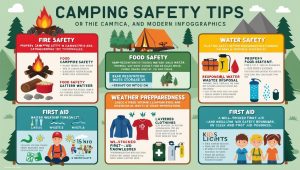
🧭 Table of Contents
-
General Camping Safety Tips
-
Fire Safety at the Campsite
-
Food Storage and Wildlife Awareness
-
Water Safety Tips
-
Weather Preparedness
-
First Aid Essentials
-
Camping Safety for Kids
-
Bonus: Printable Camping Safety Checklist
1. 🏕️ General Camping Safety Tips
Before embarking on your camping adventure, preparation is key. Ensuring safety from the start can help prevent problems down the line.
Tips:
-
Choose Well-Established Campsites: Opt for officially recognized and well-maintained campgrounds that offer essential facilities such as marked trails, clean restrooms, designated fire rings, and clearly defined camping areas. These sites are regularly monitored by park rangers or site managers, which enhances safety, reduces the risk of getting lost, and ensures better waste management and wildlife control. Choosing an established site also helps protect natural habitats by minimizing your environmental impact.
-
Inform Someone of Your Plans: Always tell a friend or family member your route, where you’ll be camping, and when you expect to return.
-
Carry a Map and Compass/GPS: In remote areas, you may not have cell service. Be sure to have navigation tools for safe exploration.
-
Stick to Trails: Avoid wandering off into the wilderness. Always stay on marked trails, especially when hiking or exploring.
2. 🔥 Fire Safety at the Campsite

Fire Safety Tips for a Safe Camping Experience
Fire is a big part of camping—whether for cooking, warmth, or ambiance. But when not managed carefully, it can become a serious hazard. Here are essential safety measures to help keep your campsite fire-safe:
-
Pitch Tents Away from Fire Zones: Set up tents at least 6 meters away from fire pits and other tents to reduce the risk of fire spreading.
-
Use LED Lanterns Instead of Open Flames: Ditch candles and oil lamps for battery-powered LED lights. They’re safer and more reliable.
🛒 Shop LED Camping Lanterns on Walmart
🛒 Find LED Lanterns on Amazon
🛒 Check Out Headlamps & Lanterns at Decathlon
-
Create a Designated Smoking Area: Keep it away from tents and gear. Always extinguish cigarette butts completely.
-
Clear Dry Brush Around Campsite: Remove flammable materials like dried leaves, grass, and branches from around your site.
-
Keep Fire-Starting Items Out of Reach: Store matches, fuel, and other combustibles safely—especially away from children.
🛒 Fire Starter Kits on Amazon
🛒 Camping Fire Starters at REI
🛒 Decathlon’s Fire Starting Tools
-
Monitor Weather and Fire Bans: Always check the local fire danger level before starting any campfire.
-
Choose a Safe Assembly Spot: Designate an evacuation area in case of fire, and brief your group on the plan.
-
Know Emergency Contacts: Have the nearest emergency services’ info readily available.

🔥 Campfire Safety Guidelines
Building a campfire? Do it the safe way:
-
Pick a Clear, Safe Area: Keep your fire far from tents, bushes, and gear. Avoid setting up under overhanging branches.
-
Dig a Fire Pit (If Needed): In the absence of a fire ring, dig a shallow pit and surround it with large rocks.
-
Skip the Accelerants: Never use gasoline or lighter fluid. Start your fire with natural materials like twigs and dry paper.
-
Put Out the Fire Properly: Douse it with water, stir the ashes, and repeat until everything is completely cold.
-
Never Leave Fires Unattended: Stay nearby and never let a campfire burn through the night.
The CFPA Europe develops and publishes common guidelines about fire safety, security, and natural hazards with the aim to achieve similar interpretation and to give examples of acceptable solutions, concepts, and models. The aim is to facilitate and support fireprotection, security, and protection against natural hazards across Europe, and the whole world. Here is a Fire safety in camping sites prepared by CFPA-E.
3. 🐻Food Storage and Wildlife Awareness
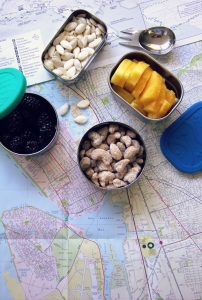
One of the joys of camping is being close to nature—but with that comes the responsibility of protecting both yourself and the wildlife. Improper food storage can attract animals to your campsite, putting everyone at risk. Follow these tips to keep your camp safe and critter-free:
-
Use Bear-Resistant Food Containers: In areas known for bears, store all food, toiletries, and scented items in bear-resistant containers or canisters. These are designed to be difficult for animals to open, keeping both your food and the wildlife safe.
🛒 Shop Bear-Resistant Food Containers on REI
🛒 Bear-Proof Canisters on Amazon
🛒 Decathlon Food Storage & Outdoor Boxes
-
Never Store Food in Your Tent: Even small creatures like raccoons or mice can sniff out snacks. Always store your food at least 100 feet from your sleeping area, ideally in a locked container or hanging from a tree (if permitted).
-
Keep Cooking Areas Spotless: After every meal, clean all cookware, utensils, and surfaces. Dispose of scraps and trash in sealed bins or wildlife-proof bags to avoid attracting animals overnight.
🛒 Camping Trash & Food Storage Bags at Walmart
🛒 Sealable Odor-Proof Bags on Amazon
-
Don’t Feed Wild Animals—Ever: Feeding wildlife may seem harmless, but it disrupts their natural foraging behavior and can make them aggressive or dependent on humans. Respect their space, and observe from a distance.
4. 💧Water Safety Tips for Campers
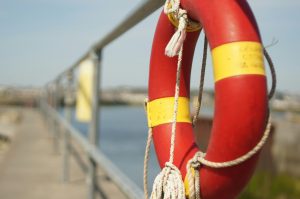
Water is essential for camping—whether you’re drinking it or enjoying recreational activities like swimming, paddling, or fishing. But untreated water and unsafe water practices can lead to serious health risks. These water safety tips will help keep your camping trip fun and illness-free.
🥤 Safe Drinking Water Practices
Even crystal-clear water from a stream or lake can carry harmful bacteria, parasites, or fecal contamination. Follow these steps to stay safe:
-
Always Purify Natural Water Sources: Never drink untreated water from streams, rivers, lakes, or ponds. To make it safe:
🛒 Top-Rated Water Filters on REI
🛒 Backcountry’s Water Filtration Gear
🛒 Affordable Portable Filters on Amazon
🛒 Decathlon’s Camping Water Purifiers
-
Bring Ample Drinking Water: If you’re camping in a remote area, always pack enough clean water for drinking, cooking, and cleaning. A general rule is at least 4 liters per person per day.
-
Store Clean Water Properly: After treating your water, store it in clean, sealed containers away from toilets, food waste, or chemical products.
🌊 Recreational Water Safety
Lakes, rivers, and the ocean can be part of the fun, but also come with risks like illness, injuries, or drowning. Keep these safety habits in mind:
-
Supervise Kids at All Times: Children should never swim alone. Stay within arm’s reach when they’re in or near the water—even shallow areas.
-
Avoid Swallowing Water: Natural water can contain harmful germs. Try not to get it in your mouth or nose.
-
Don’t Swim with Diarrhea: This can contaminate the water and spread germs to others.
-
Shower Before Swimming: Soap up before you swim and wash hands thoroughly after using the toilet.
-
Wear Protective Footwear: Sharp rocks, slippery riverbeds, or unseen hazards can cause injuries. Use water shoes or aqua socks for protection.
🛒 Best Water Shoes for Adults and Kids on Amazon
🛒 REI’s Water Footwear Selection
🛒 Budget-Friendly Aqua Shoes from Decathlon
🚱 Latrine & Sanitation Safety
-
Keep Toilets Far from Water Sources: Build latrines or dispose of waste at least 200 feet (about 60 meters) from any body of water to avoid contamination.
-
Dispose of Greywater Properly: Filter it if possible, then scatter it over a wide area away from streams or lakes.
With proper precautions, water can remain a safe and enjoyable part of your adventure. Whether you’re rehydrating after a hike or splashing with the kids in the lake, following these safety tips will help ensure your health and comfort.
5. 🌦️ Weather Preparedness
One of the golden rules of camping: always be ready for changing weather. Whether you’re out for a quick overnight stay or an extended wild camping trip, unexpected weather can affect your comfort—and your safety. Here’s how to stay one step ahead of Mother Nature.
📡 Check the Forecast Before You Go
Before heading out, always check the weather forecast for your entire route and destination. Use trusted apps like:
💡 Pro Tip: If this is your first wild camping trip, pick a familiar trail and go when weather conditions are calm.
🏕️ Choose the Right Tent for the Conditions
Your tent is your first line of defense against the elements. Choose wisely:
-
3-season tents: Ideal for spring, summer, and fall. Lightweight, well-ventilated, and perfect for mild conditions.
-
4-season tents: Designed for year-round use, including snow and high winds. These offer reinforced poles, low flysheets, and better insulation.
🛒 4-Season Tents on Decathlon
🛒 Walmart’s Full Tent Range
🛒 Amazon’s Best Camping Tents
✅ Set it up at home before your trip to practice pitching and identify any missing parts.
🧥 Dress for the Weather in Layers
Layering is the secret to comfort and safety outdoors:
-
Base Layer: Moisture-wicking (synthetic or merino wool)
-
Mid Layer: Fleece or insulated jacket for warmth
-
Outer Layer: Waterproof and windproof shell
Always pack a dry change of clothes for sleeping. Wet clothing in cold weather can be dangerous—and miserable.
🧢 Don’t forget hats, gloves, and thermal socks to keep your extremities warm.
⚠️ Pitch Your Tent in a Safe Location
Where you camp matters just as much as what you bring. Follow these location tips:
-
Avoid flood-prone areas: Don’t pitch near rivers, lakes, or valley bottoms.
-
Steer clear of dead trees or branches: They can fall during storms or high winds.
-
Find natural shelter: Low bushes or rock formations can break wind.
-
Avoid exposed ridgelines: High winds can tear out pegs or collapse your tent.
🔍 Learn How to Choose the Perfect Tent Site
📝 Final Tips for Weather Preparedness
-
Bring extra guylines and durable stakes to reinforce your tent.
-
Leave a trip plan with someone before heading out.
-
Pack emergency gear: space blanket, waterproof matches, extra food, and a backup power bank.
By preparing for all types of weather, you’ll enjoy your camping experience no matter what the sky throws at you. Stay dry, stay warm, and stay safe!
6. 🩹 First Aid Essentials
When you’re out in nature, being prepared for accidents and injuries is just as important as having the right gear. A well-stocked first aid kit, combined with some basic first aid knowledge, can make all the difference in an emergency.
Quick Tips:
-
Pack a Complete First Aid Kit: Include bandages, antiseptic wipes, tweezers, gauze, gloves, and any personal medications.
-
Learn Basic First Aid: Understand how to treat common camping injuries like cuts, burns, sprains, and insect bites.
-
Don’t Forget Insect Repellent and Sunscreen: Protect your skin from sunburn and bug bites to prevent avoidable discomfort or infections.
-
Carry Emergency Contact Info: Keep a written list of emergency numbers including local authorities or park rangers.
Where to Buy First Aid Kits
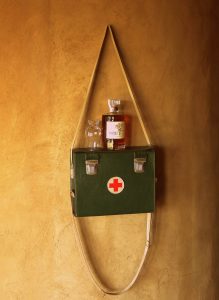
Whether you’re a weekend camper or a wild adventurer, having the right first aid kit is essential. Here are a few trusted sources:
-
Walmart – Affordable and compact first aid kits perfect for beginners and short trips.
-
Amazon – Offers a wide selection, from basic travel kits to advanced multi-day survival options.
-
REI – High-quality outdoor-specific kits tailored for backcountry camping and remote travel.
💡 Pro Tip: Even with a pre-packaged kit, customize it to fit your needs—include EpiPens, allergy meds, or extra bandages based on your trip and medical history.
What to Include in a Camping First Aid Kit
Here’s a practical checklist of items to make sure you’re fully prepared:
Wound Care
-
Adhesive bandages (assorted sizes)
-
Gauze pads and medical tape
-
Antiseptic wipes & antibacterial ointment
-
Burn gel and hydrocortisone cream
Medical Tools
-
Tweezers and scissors
-
Disposable gloves
-
CPR face shield/mask
-
Thermometer and emergency blanket
-
Instant cold packs and elastic bandages
-
Tourniquet and splint (optional for longer trips)
Medications
-
Pain relievers (ibuprofen/paracetamol)
-
Antihistamines (for allergies)
-
Anti-diarrheal and oral rehydration salts
-
Aloe gel (for sunburn)
-
Personal medications (in labeled containers)
-
Insect repellent and sunscreen
Here is a Camping_First_Aid_Checklist
Common Camping Injuries
Accidents happen—even on a smooth trail. Here are some of the most common issues you might face while camping:
-
Minor cuts, scrapes, or bruises
-
Muscle strains and sprains
-
Insect bites or tick exposure
-
Heat exhaustion or dehydration
-
Burns from cooking or campfires
-
Hypothermia in cooler conditions
By knowing what to expect and having the tools to respond, you’ll avoid turning minor issues into trip-ending emergencies.
Bonus: First Aid Resources
🩺 First Aid Training
Consider taking a course in wilderness first aid, or download the Red Cross First Aid App for on-the-go instructions—even offline!
🧠 Stay Sharp
First aid kits aren’t just for emergencies—they offer peace of mind. Before every trip, inspect your kit, replace expired items, and make sure it’s stored in a dry, accessible location.
7. 👶 Camping Safety for Kids
Camping with children requires extra attention to safety, but with some preparation, it can be a fantastic experience.
Tips:
-
Teach Kids About Boundaries: Set clear rules about where they can and can’t go around the campsite.
-
Give Kids a Whistle: This can be an easy way for them to alert you if they’re lost or in trouble.
-
ID Bracelets: Ensure your child has an ID bracelet with your contact information in case they get separated.
-
Use Nightlights: Nightlights can help comfort children and keep them oriented during the night.
8. ✅ Bonus: Downloadable Camping Gear Checklist
Explore our detailed guide on essential camping gear to make sure you’re fully prepared: What Equipment Do You Need for Camping? 2025 | Essential Camping Gear Checklist.
Conclusion
Camping is one of the most rewarding ways to connect with nature, and with the right preparation, it can be an incredibly safe and enjoyable experience. By following these camping safety tips, you’ll be able to mitigate risks and focus on what truly matters—having fun and making lasting memories with your loved ones.
Plan ahead, stay safe, and enjoy your outdoor adventure to the fullest!
